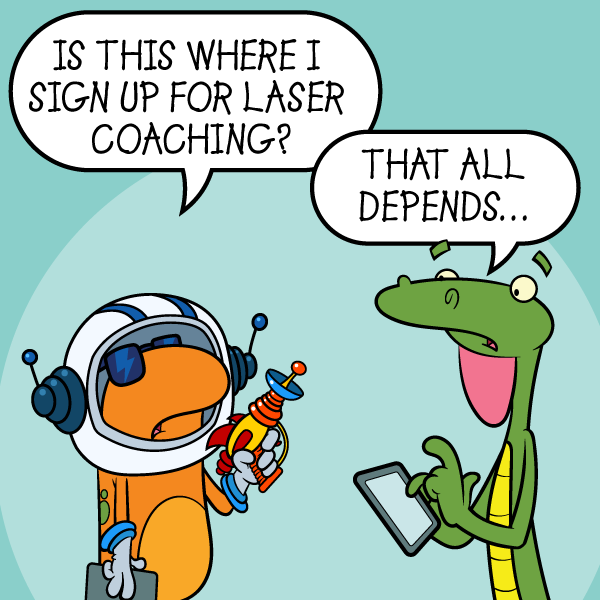How to Use Laser Coaching to Drive Agility in Your Team


A four-step approach to keep the workflow moving during stress
The biggest thief of energy in any team during periods of chronic stress arises from the stories we make up. And these stories stem from hidden fears inside us that produce what motivational speaker Zig Ziglar used to call “stinking thinking” in the 80s. Stinking thinking happens when internal alarms get triggered, and we act out by releasing those inner fears in unproductive ways.
We’ve all done it. Someone says the one thing that gets you where it hurts. The rest of the day, you’re distracted, annoyed, and much less productive. Your emotional center in the brain is triggered physiologically, and the resulting stress hijacks your amygdala, diverting vital energy away from the more productive prefrontal cortex. Worse, rumination about how to respond to the situation to get things back into equilibrium occupies brain power and diverts time better spent on work and output. It can happen to anyone, but the best leaders recognize the debilitating effect on team productivity and have learned to nip it in the bud quickly. They don’t call it coaching, but that’s what they’re doing. They ask, listen, and help others reframe their thinking to what serves the team’s best interests. And they do it fast.
Agile leaders are excellent at keeping their team focused on the mission and vision, instead of dysfunctional dynamics. They naturally seek to build team trust and integrity, two values that are the glue for team stability. For years, we’ve observed what agile leaders do best, and some of the skills we teach in laser coaching are natural to them.
What is laser coaching vs. other styles of coaching?
There are many forms of coaching used by the coaching profession and by leaders in organizations. Highly trained professional coaches are usually practitioners of either action plan coaching or transformational coaching. Action plan coaching is generally what new coaches are practicing and helps provide support and accountability for simple habit change goals. Transformational coaching is much more complex and requires a deep understanding of the human psyche and the unconscious patterns that often drive surface behaviors and outcomes. Many years of advanced study and practice are necessary to help clients transform their underlying drivers to a more productive manifestation of their true intentions.
Laser Coaching is a different approach from either of the practices mentioned above in some essential ways. Very experienced practitioners are often attracted to this method because it gets to the heart of the matter faster. For this reason, it can be beneficial for busy executives, but with one requirement. Since the method drives hard and quickly to the truth, it’s vital to ensure that both the coach and the executive have a healthy self-esteem. The approach is courageous and straightforward. Thus, ego-sensitivities can be triggered, and the coach needs to know how to process reactions quickly. For example, a revealed truth can trigger anger, and the coach must know how to help the client direct that anger productively into action, not blame.
Surprisingly, as a twenty-year veteran coach, I’ve noticed that great leaders are often excellent at laser coaching. It makes sense this might be true because they are often masters at helping people reframe their mindset and thinking to forward objectives. They recognize that coddling sensitivities will lead to corporate politics and drama, so they excel at a few “super-skills” that are observable in highly agile teams. Indeed, laser coaching is a skill that leaders in exponential organizations must have to ensure speed and high growth in innovation.
Four observable super-skills in agile leaders:
- Speed. Just like the adjective that describes it, what’s best about laser coaching is that it gets right to the point and redirects attention to what matters most before crucial time is lost. Agile leaders want their teams to focus on productivity, problem-solving, and innovation. None of those brain activities can happen if someone on the team is stirring up negative sentiments about one of their teammates. Even if there is some truth to the story (which there often is), that doesn’t make it constructive use of time. Agile leaders regularly challenge assumptions and play “devil’s advocate” to ensure everyone thinks things through honestly and wisely.
- Courage. It takes guts to take a problem directly to the person who has you concerned and annoyed. Instead, what most of us do is take our complaint to others on the team to check our point of view. But that’s the ruse we play with ourselves, that if our point of view has merit to others, then it’s legitimate. This method of avoiding direct communication is called triangulation, and unfortunately, it’s deadly for team trust. Why? Because telling someone else your complaints only serves to spread negative views even further. Then that person also floats the negativity with others. During all this, the one who could clear it up is left out of the conversation entirely. The super-skill is to summon the courage to go direct or coach someone to do so as soon as possible. Directness is crucial and points the issue to the right source immediately.
- Realism. Another benefit we notice in leaders who use laser coaching is that they help everyone stay out of the story and focus on reality. When most of us make up stories about others, what’s going on is unconscious fear that arises from the past or the future. Believing the story in our minds makes it impossible to stay in the present. The concern is about previous experiences that remind us of what’s going to happen or about the future experience we dread might happen. Agile leaders speak their truth as they see it, and help others identify the facts quickly, so stories dissipate rapidly. Clearing the mind to focus on the reality of factual information enables us to move forward constructively.
- Responsibility. After abandoning the story, everyone can take ownership of previous unconscious thoughts and reframe their mindset to align with their true intentions. Very few people intentionally plan to harm their co-workers. Their concerns often have some legitimate basis that is best resolved in conversations so each person can assert what they need and take responsibility for getting those needs met. When everyone takes responsibility for their thoughts and feelings, the focus can shift back to tangible outcomes. By far, the exponential benefits are efficiency on tasks and the effectiveness of relationships. Trust is maintained, and healthy culture ensues.
Laser coaching works great with Agile.
The popularity of the agile method used to build software faster has always been paired with coaching by the scrum master at the end of a development sprint. By taking the time to coach clients and engineers in a review meeting, teams can iterate improvements in efficiency in between intense work periods. The crucial aspect of transparency is not for those who enjoy corporate politics or civility at the expense of quality. It requires forthright honesty and an ability to trust that colleagues have reasonably healthy egos. Those who are generally satisfied with their lives, hold themselves in high esteem, and operate from a strong internal sense of self can make continuous improvement a way of life. Those with low self-esteem or ego-sensitivities best find a corporate role somewhere that is not dependent on rapid and exponential innovation or growth. There’s a place for everyone, thankfully. But if you want your team to be agile, building solid internal character strength and laser coaching skills are two imperatives. An ability to be tough while respectful can make for an intense work environment. But wicked smart talent who experience it, rarely want to go back to the games of corporate life.




